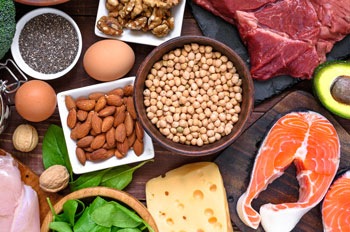Protein and Weight Loss
The effects of protein on weight loss.
 Nashville, Ark. – Americans struggle with weight loss. In fact, more than one-third
of Americans are considered obese. Being obese leads to a host of health problems
including cardiovascular disease and diabetes.
Nashville, Ark. – Americans struggle with weight loss. In fact, more than one-third
of Americans are considered obese. Being obese leads to a host of health problems
including cardiovascular disease and diabetes.
Increasing protein levels in your diet has been shown to be an effective way to combat obesity.
Protein plays an important role in the body. A large part of our body’s structural components, such as skin, muscles, bones, and organs, are made up in large part by protein. Many of the hormones that regulate body processes and chemical reactions rely on protein. Protein is also used to make antibodies to fight disease.
How does protein help with weight loss?
Protein plays a role in weight management because of its ability to increase satiety (a feeling of fullness). Although high carbohydrate meals can increase satiety (think about how you feel after eating Thanksgiving dinner), meals high in protein will help you feel full longer. In addition to satiety, a high-protein diet can help increase metabolism. Protein helps build muscle along with exercise. This helps the body burn calories even when we are resting.
How much protein does a person need?
The current minimum Recommended Dietary Allowance (RDA) for protein for adults is 0.8 gram of protein per kilogram body weight. This equals to 56 grams of protein per day for a 150-pound person. Current research suggests that as we age, protein levels need to increase. Older adults may benefit from an intake of 25 to 30 grams of high-quality protein meal per meal. This level will help older adults maintain muscle mass.
High-protein diets have received a lot of media attention over the past several years. Initially, high-protein diets were considered part of the fad diet trend. However, over the last ten years, numerous studies have been published supporting the importance of increasing protein while decreasing carbohydrate in the diet. By increasing protein to 30 percent of daily energy intake and reducing carbohydrates to 40 percent can be beneficial for weight loss.
Studies report that diets higher in protein and lower in carbohydrates increase weight loss, increase loss of body fat, and reduce loss of skeletal muscle mass. High protein diets can also reduce triglyceride levels, increase HDL (good) cholesterol, and decrease blood pressure. However, it is important to note these effects have only been observed with diets targeting weight loss.
What foods are high in protein?
 Think meat, however, there are some non-meat sources. Beef has between 30-34 grams
per 4 ounces. A chicken breast provides about 30 grams per 4 ounces. Pork provides
about 29 grams per 4 ounce serving. Fish provides between 25-27 grams per 4 ounces.
Think meat, however, there are some non-meat sources. Beef has between 30-34 grams
per 4 ounces. A chicken breast provides about 30 grams per 4 ounces. Pork provides
about 29 grams per 4 ounce serving. Fish provides between 25-27 grams per 4 ounces.
There are plenty of other vegetarian sources of protein including pumpkin seeds, cottage cheese, quinoa, tofu, and black beans.
How can I increase protein in my diet?
Some ways to increase protein include:
- Incorporate eggs, low-fat cottage cheese, low-fat yogurt, Greek yogurt, or low-fat milk into your breakfast.
- Eat snacks high in protein such as Greek yogurt, nuts, nut butters and seeds.
- Add small amounts of meat and beans or legumes to casseroles, pasta, and soups.
- Eat lean meat several meals a week.
- Incorporate more high protein plants and vegetables in your diet (beans, peas, broccoli).
- Eat fish several times a week.
For more information on increasing protein in your diet, contact the Howard County Extension Office at 870-845-7517 or visit our office located on the second floor of the courthouse. I will be glad to send you a copy of two great fact sheets, “Protein and Weight Management” and “The Power of Protein.” The Cooperative Extension Service is part of the University of Arkansas System Division of Agriculture.
Recipe of the Week - Easy Pulled Pork
Try this recipe if you are looking to increase your protein intake. It provides 33 g. of protein per serving. This recipe is easy to prepare and can cook all day in a slow cooker.
-
1 medium onion, thinly sliced
-
2 tablespoons brown sugar
-
1 tablespoon paprika
-
1 teaspoon salt
-
½ teaspoon black pepper
-
3 pounds pork tenderloin, trimmed
-
6 tablespoons cider vinegar
-
1 cup low-sodium chicken broth
-
2 teaspoons Worcestershire sauce
-
Red pepper flake, to taste
-
1 teaspoon sugar
-
1 teaspoon dry mustard
-
½ teaspoon cayenne pepper
-
Place onion in a slow cooker.
-
In a small bowl, combine brown sugar, paprika, salt, and black pepper, mixing thoroughly.
-
Rub seasoning mixture on the meat, coating evenly.
-
Place pork in slow cooker.
-
In a medium bowl, combine vinegar, chicken broth, Worcestershire sauce, red pepper flakes, sugar, mustard, and cayenne pepper, mixing thoroughly.
-
Add to slow cooker.
-
Cover and cook on low for 8 to 10 hours.
-
Remove the meat. Using two forks, shred the meat and onions coarsely and discard the fat.
-
Yield: 8 servings.
- Nutrition information per serving: Calories – 200, Fat – 4 g., Carbohydrates – 7g, Protein – 33 g, Sodium – 397 mg.
By Jean Ince
County Extension Agent - Staff Chair
The Cooperative Extension Service
U of A System Division of Agriculture
Media Contact: Jean Ince
County Extension Agent - Staff Chair
U of A Division of Agriculture
Cooperative Extension Service
421 N. Main St, Nashville AR 71852
(870) 845-7517
jince@uada.edu
The Arkansas Cooperative Extension Service is an equal opportunity institution. If
you require a reasonable accommodation to participate or need materials in another
format, please contact your County Extension office (or other appropriate office)
as soon as possible. Dial 711 for Arkansas Relay.
Pursuant to 7 CFR § 15.3, the University of Arkansas System Division of Agriculture
offers all its Extension and Research programs and services (including employment)
without regard to race, color, sex, national origin, religion, age, disability, marital
or veteran status, genetic information, sexual preference, pregnancy or any other
legally protected status, and is an equal opportunity institution.